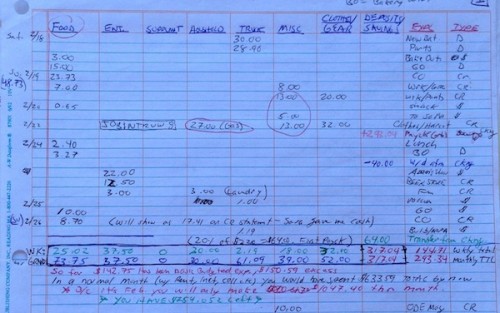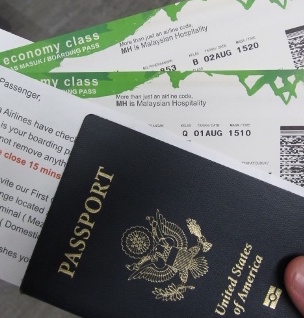How I saved $15,000 in 15 months on a $29k Salary

You don’t have to make a ton of money to save for long-term travel.
“Don’t wait around. Don’t get old and make excuses. Save a couple thousand dollars… get a world atlas. Start looking at every page and tell yourself that you can go there…Are there sacrifices to be made? Of course? Is it worth it? Absolutely. The only way you’ll find out is to get on the plane and go.”
-Jason Gaspero in Vagabonding
One of the biggest mistakes would-be travelers make is assuming that long-term travel requires a great deal of money, and that you’ll never be able to save enough to afford it. This is the ‘deferred life-plan’ concept in a nutshell: I won’t have enough money to travel until later in life when I retire, or maybe when I win the lottery, or sell a company for $10 million.
This is a bogus framework. You don’t need a lot of money to travel, and as a result you can save enough very quickly.
It’s just a matter of priorities.
—
After graduating from college in 2005 I spent 6 months trying to figure out what I wanted to do with my life. It was a period of high personal development, but before landing my first job my checking account dwindled to roughly $500.
Fast-forward fifteen months and I’d saved $15,000 on an entry-level salary of $29,000 a year. $15,000 may or may not sound like a lot of money to you, but at the time it was a small fortune and proved more than enough to fund a 1-year round-the-world trip.
It wasn’t until recently that I realized how simple, effective, and repeatable the process is. It’s budgeting 101, but something most people struggle with, mainly because it takes a lot of work.
But it’s a process I still use to get a handle on money and make things happen.
Here’s how I go about it:
#1 Realize that saving money is about priorities, and audacious goal-setting.
When I started this process, I wanted to spend a year traveling more than I wanted anything else. This is the single most important part of my plan of attack. Once you have an audacious goal all the details simply fall into place.
Find a goal that’s so compelling it’s visceral: the vision of standing next to a glacier in Argentina (above), cycling through the French countryside, or surfing the entire Pacific coast from top to bottom are examples of dreams I’ve had that almost bring tears to my eyes.
Once you have the goal there’s an implicit understanding that every dollar saved now is a a dollar available for Pisco or bus tickets later. When I’m thinking about perfect waves at some secluded destination it’s much easier to forego a great deal of mindless spending that typically goes on in the USA.
#2 Take stock by creating an asset inventory.
The next task is to write down (paper, spreadsheet, or Mint.com) all the money you have, in every account: checking, savings, CDs, money market funds, all of it. The first time I did this, it wasn’t much.
Then you have to ask yourself: how much of your net worth can be applied to a travel fund?
In this example, since most of my savings were locked up in retirement accounts the answer was basically $0. I also didn’t really have any assets to sell, like furniture or a car I was ready to part with, so I started from scratch.
Fortunately, I didn’t have any debt (and still don’t). If you have debt, read I Will Teach You to Be Rich and make a plan to get the hell out of there.
But all you’re trying to do in this step is figure out what the baseline is and what, if any, cash can be immediately applied to your savings goals. These days Mint.com makes things a lot easier than the first time I did it.
#3 Find your baseline budget by writing down all expenses.

The next step is to write down every dollar spent, every day, for 1 month.
Ramit Sethi will laugh at me for this, but it works. Like anything else, the only way to become fully conscious of what’s going on is to carefully track it. You don’t have to do this forever, but it’s so effective that the first time I continued recording my daily expenses for 6 months, and it’s a simple technique I use today whenever my finances start to feel out of control.
The answer to “how do you travel so much” turns out to be not that sexy.
Yes, it’s time-consuming and a total pain in the ass, but data-collection is also a generally useful skill: any time you want to make change in life you have to first record, then plan and execute, then re-measure. It doesn’t matter if we’re talking finances, business, or fitness: you have to get comfortable with data collection to get started.
As you can see above, every day I wrote down all expenses–I did this in a simple graph-paper notebook–then I tallied up the total at the bottom. During the day I’d use a small pocket-sized notebook and transfer expenses to the graph paper each evening. At the end of the week I reviewed the total I spent and the total by category (ie Food, Rent, Coffee, Clothes) etc.
At some point I may have plugged all this data into a Google spreadsheet. There are numerous online tools to do this automatically for you today (eg Mint.com), but the key is to keep it simple. In my opinion, the act of writing things on paper is more effective than glancing at an online feed.
#4 Create a budget and plan of attack.
Once you have a month of data it can be surprisingly easy to cut costs. Oh, I’m spending $200 a month on beer. Hmm..
Now that you know how much is going out the door, the trick is to a) cut as many fixed costs as possible, b) determine exactly what you can afford to save for your travel bankroll and c) decide what’s left that you can use to pay for variable expenses, and d) automate everything so you don’t have to think about it.
Based on what you’ve written down in step 3, it’s easy to create a budget around the three categories:
- Current Fixed Expenses: Rent + Utilities, Cell Phone, Car Insurance, Health Insurance
- Target travel bankroll
- Current Variable Expenses: Food, Gas, Alcohol, Clothing, Entertainment, Gear, Misc, etc.
1. Fixed Expenses
It’s easy to tally these up: what do you spend on rent, phone, car insurance, etc? The real trick is figuring out which of these you can drastically cut.
The biggest X-factor in my budgeting success for the original experiment was location: I was living in the small college town of Corvallis, OR. My rent at this point in my life was only $375 / mo. including utilities, because I lived in a shared apartment. I opted to throw out my cell phone and make calls with Skype (it may have actually been a Vonage wifi phone) since anyone I wanted to get in touch with was geographically close to me. I drove a cheap vehicle, so I dropped my car insurance down to the lowest possible tier. I was younger, so health insurance didn’t cost much.
As I said, it’s much easier to make these kinds of ‘sacrifices’ with a clearly defined mission: when you know the extra $50 a month is going directly into a travel fund that you’ll be using next year.
If you’re thinking this is impossible because you live in an expensive city: I followed the same plan of action 3 years later in San Francisco. The cost cuts were just as dramatic even though the overall budget was massively inflated: $1300 / mo rent down to $700, for example.
Some things to consider: moving to a cheaper apartment, lowering your insurance coverage, and dropping to a cheaper cell-phone plan. A few big wins here can add up quickly, but you really have to be honest about needs vs wants. I got along just fine without an iPhone before they were invented (NFW!).
2. Target Travel Bankroll
Originally, I had no idea how much to save for travel, so I estimated $15,000 would last me for a while. This turned out to be a surprisingly good estimate, but it lasted much longer than I would have thought.
A note on travel budgets: I’ve found that $50 a day is a great place to start: $1500 a month should cover you almost anywhere, although I’ve only spent an average of about $1,200 a month.
The point is to make a specific target, whatever that may be, then divide that by the number of months until you leave. In this case a target of $15000, 15 months, so $1000 a month. Yikes.
3. Variable Expenses
Consider these the dregs of your budgeting efforts. Anything that didn’t make the first cut.
How many times a week do you need to eat out anyway? Did you really need the 5 DVD at-a-time Netflix plan? And absolutely get rid of Cable TV.
This is where having fixed expenses and the travel bankroll established makes it easy:
Money left over for Variable Expenses = After Tax Earnings – (Travel savings + Fixed Expenses)
Once you have a ballpark number for variable expenses, go back and allocate it by category. So maybe $100-200 a month for bars and eating out, $300 for groceries, etc.
But the important thing to remember is that if you allocate $100 a week to entertainment/booze/whatever, once the money is gone you don’t spend any more on that category. In my example here, after I spent this I just didn’t go out. Or I’d go out and only drink soda water, whatever I could do to cut costs.
This isn’t asceticism, it’s prioritization. It’s conscious spending.
So what if people think you’re cheap. They don’t realize you’re trading 10 units of fun now for 50 units later.
Putting it all together + My Example Budget from 2006
The first time I did this, my target to leave was about 15 months away, so I needed to save $1,000 a month, or about 40-50% of my after-tax income. I knew I could do it because I had the numbers on paper. All I had to do was show up for the next 15 months.
This is roughly what it looked like:
Income:
- $2200 net takehome
Fixed Expenses:
- $375 – Rent
- $35 – Car Insurance
- $30 – Skype/Wifi Phone
- $100 – ‘retirement’ savings (Roth IRA)
Travel Savings:
- $1000 per month
So $540 + $1000 = $1540 per month. That left $660 per month for variable expenses.
Variable Expenses:
- $300 – Groceries
- $100 – Bars/Entertainment
- $50 – Gas
- $100 – Gear
- $110 – Misc
Yep, I wasn’t balling, but I had plenty of leftover cash to cover the bases.
Most people will have much larger numbers in all of these categories, and these days I do too. But it’s really about properly managing money in vs money out.
#5 Automate the system so you don’t have to think about it.
After a few months following the budget it was easy. I knew how much I generally spent on different categories, and I developed a more intuitive feel for how I was doing.
But the most important thing you can do to solidify this routine is automate the whole system.
I have a fully automated financial system now, but the first time I did this I logged into my checking account and set up an automatic-transfer for the day after I got paid. In my case, I was getting paid once on the last day of the month, so I set up an automatic transfer on the first from checking to savings of $1000 per month. This secured my travel savings as a top priority.
The key is to quickly and automatically funnel money you don’t want to spend out of reach.
Next, I paid my rent on the 1st and set up all my other fixed income bills besides to pay automatically on the 1st using my airline miles reward credit card. I always paid the credit card off monthly, never carrying a balance, so I earned a bunch of frequent-flyer miles (and credit) through this is as well.
Since all savings and fixed costs were taken care of, anything left went to variable expenses. I lived on rice and cheap vegetables for a while, but it was worth it.
Conclusions after 2+ Years of Traveling
I’ve now used this 5-step plan 3 times since 2006 to save money for both travel and other goals, and it wasn’t until recently that I realized this is just a standard operating procedure. You may think it’s ridiculous that I wrote it all down, but I’m blown away by how many people I’ve met that don’t get these fundamentals. I’m also blown away that I was resourceful enough to save $15000 while making a salary below the poverty line in many parts of the US.
It reminds me how much is possible with the right priorities and plan of action.
So make a plan, save some money, and get out there.
For more, check out the most down-to-earth book on how to manage your finances : I Will Teach You to be Rich.
How do you manage money?




